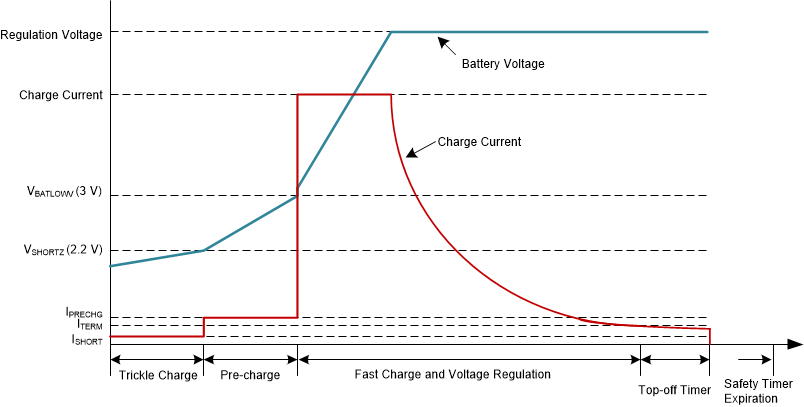SLUSDF7A January 2020 – February 2022 BQ25616
PRODUCTION DATA
- 1 Features
- 2 Applications
- 3 Description
- 4 Revision History
- 5 Description (continued)
- 6 Device Comparison Table
- 7 Pin Configuration and Functions
- 8 Specifications
-
9 Detailed Description
- 9.1 Overview
- 9.2 Functional Block Diagram
- 9.3
Feature Description
- 9.3.1 Power-On-Reset (POR)
- 9.3.2 Device Power Up From Battery Without Input Source
- 9.3.3 Power Up From Input Source
- 9.3.4 Boost Mode Operation From Battery
- 9.3.5 Standalone Charger
- 9.3.6 Power Path Management
- 9.3.7 Battery Charging Management
- 9.3.8 Status Outputs ( PG, STAT)
- 9.3.9 Protections
- 9.4 Device Functional Modes
- 10Application and Implementation
- 11Power Supply Recommendations
- 12Layout
- 13Device and Documentation Support
- 14Mechanical, Packaging, and Orderable Information
Package Options
Mechanical Data (Package|Pins)
- RTW|24
Thermal pad, mechanical data (Package|Pins)
- RTW|24
Orderable Information
9.3.7.2 Battery Charging Profile
The device charges the battery in five phases: battery short, preconditioning, constant current, constant voltage, and top-off trickle charging. At the beginning of a charging cycle, the device checks the battery voltage and regulates current and voltage accordingly.
Table 9-5 Charging Current Setting
| VBAT | CHARGING CURRENT | DEFAULT SETTING |
|---|---|---|
| < 2.2 V | IBAT_SHORT | 100 mA |
| 2.2 V to 3 V | IPRECHG | 5% of ICHG pin setting |
| > 3 V | ICHG | ICHG pin setting |
 Figure 9-5 Battery Charging Profile
Figure 9-5 Battery Charging Profile